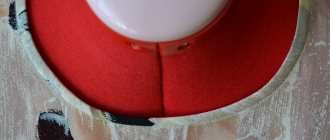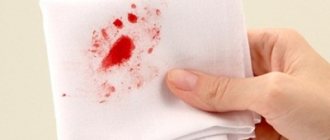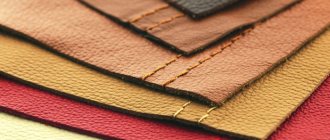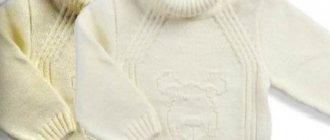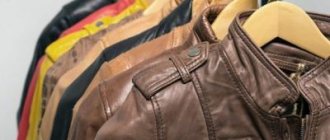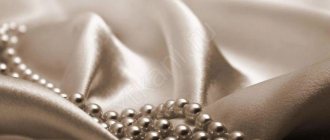Many buyers ask the question: how to distinguish natural silk from artificial silk? The question is more than relevant! After all, modern technologies make it possible to create analogues that are as close as two peas to real natural material.
The “trick” of substitution is often used by unscrupulous sellers: they offer fabric made from viscose, acetate and even pure synthetics (nylon, polyester, polyacrylic) at the price of more expensive real silk.
To avoid getting into trouble, you need to clearly understand the difference between artificial silk and natural silk. To do this, you need to know the characteristics of the materials. Better yet, arm yourself with one of the many reliable verification methods!
What is the difference between natural silk?
Natural silk is usually understood as a fabric that is made from silk thread extracted from the cocoon of the silkworm.
To obtain the coveted cocoons, insects are raised in special incubators. It is clear that the process is not quick and not cheap, which determines the relatively high cost of the original silk fabric.
Such well-known fabrics as satin, organza, satin, chiffon, foulard and a number of others are woven from natural silk threads. All these fabrics are highly breathable, hygroscopic, elastic, durable, and hygienic. They have a smooth glossy surface and fit pleasantly to the skin. They produce various types of women's and men's clothing, underwear, and household textiles.
Quality of silk fabric
The beauty of silk and its practical advantages contribute to the popularity of this fabric in many areas of industry, not to mention the fashion world.
Silk is especially actively used by famous Italian brands. The texture of the fabric allows you to turn the fantastic ideas of designers into reality. Its incredible lightness, shimmering shine and at the same time amazing strength allow the fabric to be used in sewing a wide variety of clothes. In addition to the peculiarities of the weaves, the quality and beauty of the fabric is influenced by the rearing of silkworm caterpillars. For example, if the fabric label says “100% KBT SEIDE” (100% silk) or “ORGANIC SEIDE”, then this means that the material is environmentally friendly. That is, when raising silkworms, selected foliage was used to feed it, hormones were not used to accelerate the growth and size of insects, and mulberries were not treated with harmful chemicals. The quality of the fiber depends on the leaves on which the caterpillars feed.
If they are fed oak leaves, they get coarser fibers.
Today, most women can afford to buy natural silk fabric. However, there are also those whose family budget does not allow them to do this. Viscose and various synthetic fabrics have long been used as such materials. Naturally, the price of these materials is much lower.
How are silk fabric analogues made?
The main and key difference between natural silk and artificial silk is that it is obtained from real silkworm threads. Analogues are made from cellulose (wood).
This is what cellulose “silk” looks like:
To obtain viscose, wood chips are treated with carbon disulfide and then passed through perforated filters. To obtain acetate, cellulose raw materials are treated with acetic anhydrite. In both cases, strong threads are obtained, comparable in many properties to natural silk.
Main characteristics of artificial silk
Artificial silk has been produced since the beginning of the 20th century; the fabric is based on viscose fibers obtained from the processing of cellulose. The cellulose undergoes special chemical treatment to produce thin and smooth fibers. This is a very low-maintenance and low-cost material.
Currently, other fabrics such as polyester and polycotton are also classified as artificial silk; they also have a beautiful appearance, a smooth, even surface and excellent breathability. In addition, such fabrics have good resistance to various mechanical damage and deformation, are resistant to fading and are very durable. One of the advantages is also its low maintenance requirements. Cheaper analogues can accumulate static electricity, so the best option for a cellulose analogue of silk would be a material that does not have impurities.
So, we have looked at the most popular ways to distinguish natural silk from artificial silk. Now you can easily and simply choose a natural fabric that will provide you with comfort, convenience and aesthetic pleasure.
What are the differences?
Artificial and natural silk are comparable in many ways. For example, viscose material is also soft and pleasant to the body, folds beautifully in waves, and is slightly electrified. Acetate has less strength, does not absorb moisture well, sticks when heated, and becomes electrified.
Synthetic materials are the least similar to natural silk. Nylon, polyester and polyacrylic are lightweight fabrics with a shiny, smooth surface. But they feel completely different to the touch, and things made from them are by no means as comfortable. Synthetics tend to accumulate electricity, shed quickly, and are easily flammable.
We hope you now understand the difference between real and artificial silk, and if necessary, you can easily distinguish a fake using one of the methods described.
How to distinguish natural silk from artificial and synthetic
Manufacturers of artificial silk have achieved such skill that it has become difficult to distinguish this fabric from natural one. It shines just as luxuriously, just as soft and smooth. Unscrupulous sellers can take advantage of this by selling artificial or synthetic silk at the price of natural silk.
There are several ways to recognize natural silk fabric:
- Squeeze a piece of fabric in your fist - natural silk will straighten out without leaving any creases. Unnatural - it will wrinkle.
- Natural silk heats up from the body, keeping it warm, while artificial silk remains cold.
- Natural silk is light, weightless, flowing.
- Too bright shine instead of a pleasant iridescent shimmer is a sign of artificial fabric.
- The natural material is thin but durable. It is difficult to tear in both dry and wet conditions. Wet synthetics tear easily.
- In natural silk, the tip of the thread at the break point looks like a bundle of many fibers, while in artificial silk it looks like a tassel.
Life hack for the brave: ask the seller for a fabric sample and set it on fire. Natural silk does not burn, but rather smolders, giving off the smell of burnt hair or feathers. The burning of rayon is accompanied by the smell of burnt paper, and synthetic fabric emits a corresponding chemical smell.
Both natural, artificial, and synthetic silk have their admirers, since each person has their own priorities and selection criteria. Our online store has a wide range of silk fabrics of various types, go and choose.
How to distinguish natural fabric from synthetic
Unfortunately, many people are completely unable to determine the composition of the fabric and wear synthetics, quite confident that it is silk. This article describes the properties of various fibers and simple methods for determining the composition of fabrics. This knowledge will be useful to some when choosing materials, and will save others from mistakes.
Textiles are made from natural fibers, artificial fibers, synthetic fibers, or, finally, from a mixture of different fibers.
Cotton, linen, wool and silk are natural fibers.
Viscose, acetate and triacetate are obtained chemically from natural substances (cellulose), which is why they are called artificial fibers.
Nylon, dacron, nitron, chlorin, vinol, spandex (elasthan, lycra), nylon (anid) and polyvinyl chloride are obtained from synthetic compounds and are therefore called synthetic fibers.
In cases where there is no label on the products indicating the fiber material, you can try to determine the type of fibers yourself - by appearance, creasing, and also by doing various tests - for acetone, for the nature of combustion.
☝️Remember the main rule! Be sure to check both threads - both the warp and the weft, since it often happens that the warp is made of a more expensive fiber (for example, silk), and the weft is made of a cheaper one (for example, viscose).
*warp thread: runs along the fabric
*weft thread: goes across the fabric
Cotton and linen.
Fibers of plant origin. Cotton from the cotton plant, flax from the flax ear. The fibers burn quickly with a bright flame followed by a glow and a small amount of white smoke. After the flames die out, they smolder for a long time, producing dark gray ash and the smell of burnt paper. Flax smolders worse and dies out faster, leaving virtually no ash or pungent odor. Pure cotton always feels soft and warm to the touch. If you squeeze it in your hand, the fabric will wrinkle greatly. Linen also wrinkles easily. If you look closely at the fabric, linen threads are often uneven in thickness. The material itself looks more shiny and smooth than cotton, but it drapes much worse. The fabric is hard and cool to the touch. Linen does not stretch well across the weft and warp.
Natural viscose.
They are made from wood, or rather from cellulose, and viscose is obtained from it. Viscose and copper-ammonia fibers are very similar in properties to cotton staples and differ from them only in their silk-like appearance (which is why sellers often pass off viscose fabrics as silk). This fiber has all the properties of cotton, although it is produced chemically; viscose can safely be classified as a natural fabric. So, it burns very quickly, like gunpowder or cotton wool. When the flame dies out, it smolders for a very long time, forming a pungent, thick smell of burnt cotton wool, leaving gray smoke and ash that easily crumbles in your hands. Weight will also help to distinguish viscose fabric from silk. Since the density of viscose is higher, fabrics made from this fiber are heavier than silk. The fiber has a bright “silk” shine (if it is without additives), soft and pleasant to the touch, drapes easily, and does not electrify.
Wool and silk.
Animal fibers. Wool is produced from the hair of animals, and in the production of silk, threads produced by the silkworm are used. When burned, these fibers behave the same. They burn slowly, the fibers seem to curl up and twist. Silk without a flame goes out immediately. Wool, after fading, does not smolder. The resulting coal is in the form of a soft lump that can be easily crushed with your fingers. The smell when burning is burnt hair, feather or burnt horn. When examined closely, you can see the unevenness of some threads; knots are not a drawback; on the contrary, it is in chemically produced fabrics that the thread is always even. The material has a pleasant shine. It feels warm and pleasant to the touch.
If soot is released when wool burns, then it is an admixture of lavsan or nitron; if you smell beans, it is an admixture of nylon; if the smell of burnt paper is mixed with the smell of wool, an influx is formed and a flickering ember is visible, then it is an admixture of viscose or acetate.
Acetate and triacetate.
Acetate fabrics are no different in appearance from silk; products made from them are less wrinkle-resistant, hold wrinkles well and are worn better than items made from cotton and viscose. Acetate fabrics are quite elastic and retain heat well. They burn and melt both in the flame and outside the flame. They also leave behind a dark influx and a hard lump. For example, acetate fiber also dissolves in acetone. If a fabric dissolves in acetone, then it probably belongs to acetate and triacetate, since acetone has no effect on all other fabrics.
Synthetic materials.
The initial raw materials for production are oil and gas processing materials (types of fibers - polyamide, polyvinyl chloride, polyester, etc.). Obtained chemically. What they have in common is that when they burn, they melt, forming black smoke and an influx, sintering into a lump that cannot be crushed with your fingers after extinguishing. Spreads the sour smell of synthetics
Mixed fabrics. They will burn the same way as the predominant fiber in the composition burns. For example, if the fabric is wool with the addition of lavsan, then it will smell like wool, but the lump will not completely crumble after it fades.
Always rub the extinguished wick between your fingers! If there is an admixture of synthetics, then you will definitely feel hard balls.
How to check that silk is natural. How to identify natural silk
Silk was invented in China, where it was considered the fabric of emperors and was worth its weight in gold. Products made from this luxurious material are not only pleasing to the eye and pleasant to the touch - they are also incredibly practical: they are durable, strong, soft and almost do not wrinkle. All this is true provided that the silk is natural and not artificial, because so far no technology has been able to reproduce all the qualities of this amazing material.
When purchasing a silk product, always ask the seller to show a quality certificate. But it’s better to play it safe and check the naturalness of silk in several more ways.
1. Take a closer look at the structure of the fabric - if its surface is perfectly smooth, in this case this is not an advantage, but a disadvantage. You may have come across polyester, because real silk usually has slight irregularities.
2. Pay attention to the color and shine of the fabric. Real silk is not completely white; its threads should have a light creamy tint. Natural silk has a noble, soft shine, shimmers in the sun, playing with shades. The shine of artificial fabric is poorer, the glow is white.
3. Silk of natural origin acquires body temperature, so it warms you in cold weather and prevents you from overheating in hot weather. If you press the fabric against your hand and feel cool, the fabric is artificial. Crumple the fabric into a ball - there should be no clear creases on it.
4. Carefully pull out a few threads from the fabric and set them on fire. Natural silk burns, releasing a pungent odor of burnt wool or feathers. The threads curl into charred balls and turn to ash when rubbed with your fingers. Artificial silk will melt when burned, giving off the smell of burning plastic or burnt cellulose.
5. Please note that natural silk will not be sold in vacuum packaging. Otherwise, it will “suffocate” and begin to emit a moldy smell.
6. The quality of silk can be determined by trying to tear it. It is almost impossible to damage natural silk in this way: its threads have the strength of steel wire, but artificial fabric may not withstand it.
7. Please note that the price of natural silk cannot be low. If a merchant easily gives in to persuasion to reduce the cost of a product by half, most likely you are dealing with a fake.
8. There is another way to check the naturalness of silk. Dip it in a 7-10% alkali solution and heat it. Silk fabric is of natural origin (the threads for it are produced by silkworms), so it will dissolve without a trace. Artificial fabrics will pass this test. Despite the accuracy of the method, unfortunately, it will not be possible to apply it in a store or market - unless you intimidate the seller, who does not want to reveal the truth about the origin of the fabric.
How to determine the type of fiber - combustion test
The comfort of a product in sewing and wearing largely depends on the fibrous composition of the threads from which the fabric is made. Unfortunately, the fiber composition of fabrics is not always indicated correctly or is not indicated at all. Therefore, it is important to learn how to determine the fibrous composition yourself.
The fibrous composition can and should be determined by appearance, touch and the nature of combustion. A combustion test is the simplest and most accurate way to determine the fibrous composition of a material. All you need for this is a piece of material, tweezers, a lighter and a saucer.
When conducting a combustion test, we pay attention to the nature of the flame, smell, density and color of the ash. Next, watch the video or read the text below
More natural plant fibers
Cotton, flax, nettle, hemp... are based on the natural polymer cellulose.
Combustion character: Burns with an intense yellow flame. After fading, there is a light smoke with the smell of burnt paper. After combustion, a light, fragile gray-white ash remains, which can be easily rubbed with your fingers.
Natural animal fibers
Natural silk is based on a natural polymer, the protein fibroin. Wool is based on a natural polymer, the protein keratin.
Character of combustion: When brought into the flame they light up, when taken out of the flame they die out. The smell of burnt hair (feather, bone). After combustion, dark, brittle ash remains and can be easily rubbed with your fingers.
Wool has a richer smell of burnt hair than natural silk.
Man-made fibers
Viscose, bamboo - based on natural polymer cellulose
The combustion pattern is similar to cotton: Burns with an intense yellow flame. After combustion, a fragile ash of gray or dark color remains, which is easily rubbed with your fingers.
Synthetic fibers
When introduced into the flame, nylon melts and ignites with difficulty. If the molten mass begins to drip, combustion stops and a melted ball forms at the end.
Lavsan and nitron burn with a yellow, smoky flame, forming a hard melted ball that does not crumble or grind with great difficulty. A hard melted edge is formed on the edge of the material
Unpleasant smell - burnt plastic
In the video you saw how the most common synthetic materials burn. Perhaps the pieces of fabric that you examine will have a slightly different combustion pattern. This is normal, because fibers are often mixed in different combinations, fabrics undergo a wide variety of finishes, and this all undoubtedly affects the combustion behavior.
By and large, your task is to learn to distinguish between natural materials and synthetic ones. And distinguishing synthetic ones from each other is not so important.
The key to the success of a future product is the right choice of fabric. If you choose a fabric solely based on the criterion of “like it or not” and “the color is cheerful,” then it is difficult to count on a good result. The color may be cheerful, but how will it be sewn?
To learn how to easily choose fabrics that are easy to sew and comfortable to wear, come to the master class “Matter is Primary: How to Choose the Right Fabric”
DO YOU THINK THIS WOULD BE USEFUL FOR YOUR FRIENDS? SHARE WITH THEM ON SOCIAL NETWORKS!
